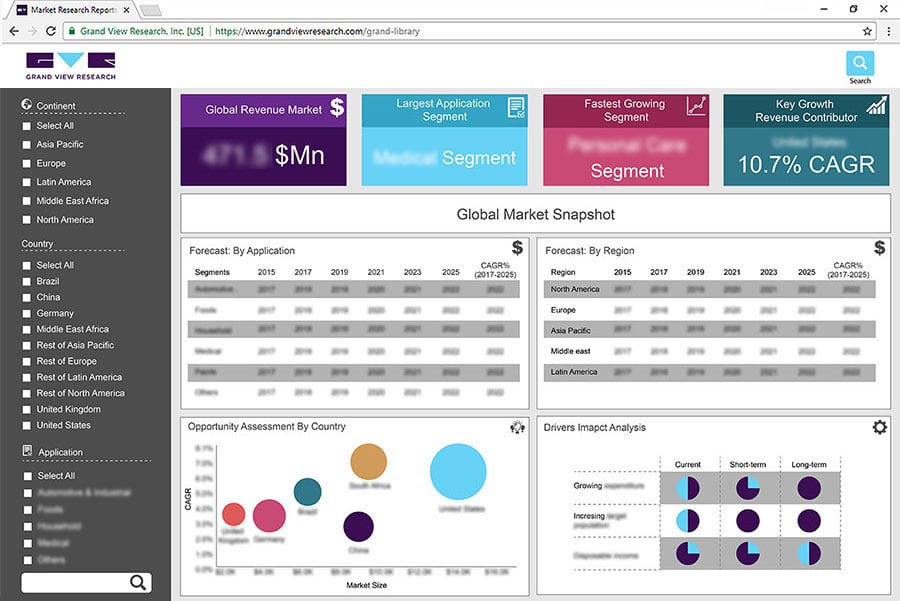- Home
- »
- Next Generation Technologies
- »
-
Decentralized Finance Market Size And Share Report, 2030GVR Report cover
![Decentralized Finance Market Size, Share & Trends Report]()
Decentralized Finance Market Size, Share & Trends Analysis Report By Component (Blockchain Technology, Smart Contracts), By Application (Payments, Stablecoins), By Region, And Segment Forecasts, 2023 - 2030
- Report ID: GVR-4-68039-976-9
- Number of Report Pages: 110
- Format: PDF, Horizon Databook
- Historical Range: 2020 - 2021
- Forecast Period: 2023 - 2030
- Industry: Technology
Decentralized Finance Market Size & Trends
The global decentralized finance market size was valued at USD 13.61 billion in 2022 and is expected to expand at a compound annual growth rate (CAGR) of 46.0% from 2023 to 2030. The widespread acceptance of Decentralized Finance (DeFi) has brought about a significant revolution in the financial sector, becoming a key driver for market growth. Over the past few years, the integration of DeFi with decentralized blockchain platforms has gained immense popularity. The increasing adoption of decentralized finance can be attributed to its capability to remove intermediaries from financial processes. Particularly in the insurance industry, the impact of DeFi has been remarkable, as it addresses the challenges posed by complex procedures, paperwork, and audit systems in traditional systems. By leveraging decentralized finance platforms, the insurance industry has become more efficient, thereby contributing to the market's overall growth.
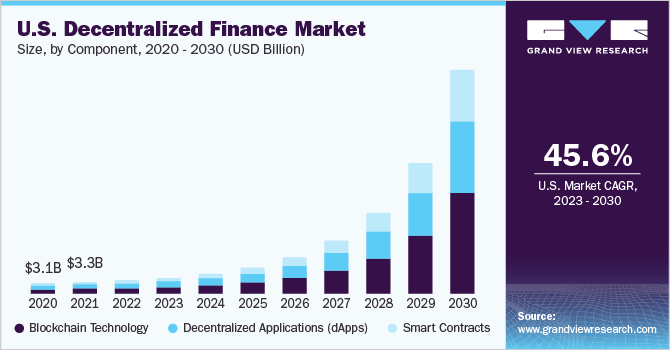
The market growth is driven by the numerous advantages offered by DeFi technology providers. One of the key advantages is the elimination of centralized financial institutions, such as banks, which traditionally exercise control over money, financial products, and services. Furthermore, DeFi systems eliminate the fees imposed by banks and other financial institutions to access their services. In addition, the user-friendly nature and easy accessibility of decentralized finance platforms are expected to boost their adoption further, as they can be accessed by anyone with an internet connection without the need for authorization.
The rise of e-sports and gaming has emerged as a significant catalyst for the growth of Decentralized Finance (DeFi) platforms, as developers increasingly utilize DeFi tokens for in-app purchases. Furthermore, trading games and collectibles have gained popularity as genres on the blockchain, empowering users to trade tokens and build their unique ecosystems. An example is Augur, a DeFi platform that enables users to place bets on various world events, sports, and economic outcomes. The advent of blockchain-based prediction solutions is expected to unlock new opportunities for market expansion in the foreseeable future.
DeFi platforms offer a range of features that contribute to their market growth. These include the ability to send money globally, securely store funds in cryptocurrency wallets, and trade tokenized assets such as stocks and mutual funds. The convenience of accessing these platforms through smartphones adds to their revenue potential. In addition, decentralized finance platforms have witnessed increasing popularity among cryptocurrency enthusiasts, attracting investors from various countries, which is projected to drive further growth in the market.
While Decentralized Finance (DeFi) platforms offer numerous innovative advantages but also have certain risks, currently, the infrastructure and regulations surrounding DeFi are still in development, meaning that investments in DeFi are not subject to the same level of regulation and insurance as traditional banking. Furthermore, decentralized finance loans rely on additional crypto assets as collateral, which can experience significant value declines or even liquidation during market downturns. However, the DeFi industry is actively working to enhance its functionality, security, and scalability to accommodate the growing number of participants in the digital asset space. This evolution is already underway with the transition to the Ethereum 2.0 network. It is expected that DeFi platforms and exchanges will continue to enhance privacy and independence in cryptocurrency trading, thus driving the advancement of decentralized finance and the underlying systems supporting it.
Market Dynamics
Decentralized Finance (DeFi) insurance is an emerging trend within the DeFi space. It plays an essential role in driving the adoption of decentralized exchanges. DEXs are often considered a safer alternative to centralized exchanges because they allow users to maintain control of their funds. DeFi insurance includes the provision of insurance policies through blockchain rather than traditional policies, as well as coverage for activities conducted over blockchain. It protects against risks such as crypto wallet hacks, liquidity issues, and other security concerns. It also provides coverage for losses due to smart contract bugs or hacks to protect against theft of assets and other risks associated with trading on DEXs, thus providing users with greater confidence to use decentralized exchanges and boosting adoption of these platforms. Moreover, DeFi insurance attracts institutional investors to decentralized exchanges by providing them with the security and risk management tools they need to participate, drive liquidity, and increase the overall volume of trading on DEXs.
COVID-19 Impact Analysis
The COVID-19 pandemic has triggered a transformative shift in various industries, primarily driven by the adoption of blockchain technology. One of the key drivers during the pandemic has been the demand for streamlining and automating supply chain applications and business operations. Moreover, investors are seeking opportunities to generate profits at a time when central banks globally have lowered interest rates to stimulate economies grappling with the adverse effects of the pandemic.
Component Insights
The blockchain technology segment dominated the market in 2022 and accounted for a share of more than 41.0% of the global revenue. Blockchain technology can replace existing decentralized business model foundations by lowering transaction costs, fostering distributed trust, and empowering decentralized platforms. Blockchain technology enables the emergence of decentralized financial services in the financial sector, typically more innovative, interoperable, decentralized, borderless, and transparent. Decentralized financial services driven by blockchain technology can increase financial inclusion, provide open access, promotes innovation, and open up new business and innovation prospects.
The smart contracts segment is anticipated to witness significant growth over the forecast period. Smart contracts are the foundation of DeFi protocols and applications. A smart contract can operate as a custodian with specific rules for when, how, and who can receive these assets. Moreover, it speeds up decentralized financial operations, including investing, lending, banking, and insurance. In addition, centralized finance platforms can become decentralized through smart contracts, which is anticipated to create unique opportunities for the segment’s growth.
Application Insights
The data and analytics segment dominated the market in 2022 and accounted for a market share of more than 18.0% of the global revenue. Decentralized finance protocols offer significant benefits for decision-making and data analysis. Owing to DeFi protocols' openness in data and network activity, DeFi protocols help in risk management and generate business opportunities. With the help of the capabilities offered by DeFi platforms, users can compare yield and liquidity and evaluate platform risks using various dashboards and tools.
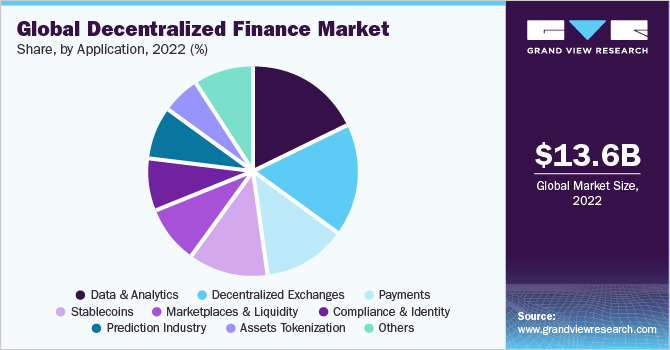
The payments segment is expected to register the fastest growth over the forecast period. Peer-to-peer payment is the fundamental use case for the DeFi industry and the blockchain ecosystem as a whole. Users may securely and directly exchange crypto currencies with one another using blockchain technology, thereby eliminating the need for intermediaries. DeFi payment solutions assist large financial institutions in optimizing market infrastructure and better serving their wholesale and retail customers. Furthermore, it also fosters a more open economic system for underbanked and unbanked communities.
Regional Insights
North America dominated the Decentralized Finance (DeFi) market in 2022 and accounted for a share of over 35.0% of the global revenue. The dominance can be ascribed to the presence of prominent players such as Compound and Uniswap. Additionally, North America is one of the world’s largest crypto markets, which bodes well for adopting the DeFi market. According to the 2021 Geography of Cryptocurrency Report by Chainalysis, from July 2020 to June 2021, DeFi transactions accounted for 37% of all transactions in North America, with inhabitants contributing about USD 276 billion in cryptocurrency to DeFi platforms.
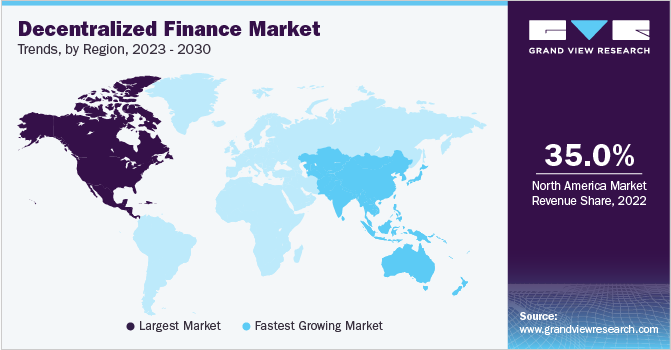
Asia Pacific is expected to grow at the highest CAGR over the forecast period. The growth can be attributable to strong economic growth and rapid technology adoption in Asian countries. There are currently numerous instances of DeFi platforms and other organizations operating with blockchain technology in the Asia Pacific region. In June 2022, Huobi Global, a digital asset exchange company, launched Ivy Blocks, which is a new investment arm focusing on decentralized finance (DeFi) and Web3 projects. Such strategic initiatives taken by market players are contributing to the regional market’s growth in the Asia Pacific.
Key Companies & Market Share Insights
The Decentralized Finance (DeFi) market has witnessed a surge in players aiming to gain market share and establish a competitive edge. Various entities, including blockchain startups, financial institutions, and technology players, actively participate in this rapidly evolving landscape. To capture market share, these players employ different strategies. Blockchain startups are at the forefront of DeFi innovation, leveraging their expertise in decentralized technologies to create novel solutions. They focus on developing robust and secure platforms that offer a wide range of DeFi services, such as lending, borrowing, trading, and yield farming.
Strategic collaborations between market players have been observed in the Decentralized Finance (DeFi) market. For instance, in March 2023, AllianceBlock, a company focused on creating seamless connections between decentralized finance (DeFi) and traditional finance (TradFi) through its trustless and decentralized infrastructure, formed a collaboration with ABO Digital, Alpha Blue Ocean's private digital asset investment arm. The collaboration aims to offer tokenized structured products tailored for institutions and crypto projects seeking alternative financing options. By utilizing AllianceBlock's decentralized blockchain infrastructure and the Nexera Protocol, traditional financial instruments can be tokenized, providing an avenue for capital providers who prefer not to hold digital assets to participate through traditional Actively Managed Certificates (AMCs). Some of the prominent players in the global decentralized finance market are:
-
Compound Labs, Inc.
-
MakerDAO
-
Aave
-
Uniswap
-
SushiSwap
-
Curve Finance
-
Synthetix
-
Balancer
-
Bancor Network
-
Badger DAO
Decentralized Finance Market Report Scope
Report Attribute
Details
Market size value in 2023
USD 16.33 billion
Revenue forecast in 2030
USD 231.19 billion
Growth rate
CAGR of 46.0% from 2023 to 2030
Base year of estimation
2022
Historical data
2020 - 2021
Forecast period
2023 - 2030
Quantitative units
Revenue in USD million and CAGR from 2023 to 2030
Report coverage
Revenue forecast, company market share, competitive landscape, growth factors, and trends
Segments covered
Component, application, region
Regional scope
North America; Europe; Asia Pacific; Latin America; MEA
Country scope
U.S.; Canada; U.K.; Germany; France; China; India; Japan; South Korea; Australia; Brazil; Mexico; Kingdom of Saudi Arabia (KSA); UAE, South Africa
Key companies profiled
Compound Labs, Inc.; MakerDAO; Aave; Uniswap; SushiSwap; Curve Finance; Synthetix; Balancer, Bancor Network; Badger DAO
Customization scope
Free report customization (equivalent to up to 8 analysts working days) with purchase. Addition or alteration to country, regional & segment scope
Pricing and purchase options
Avail customized purchase options to meet your exact research needs. Explore purchase options
Global Decentralized Finance Market Report Segmentation
The report forecasts revenue growth at global, regional, and country levels and provides an analysis of the latest industry trends in each of the sub-segments from 2020 to 2030. For the purpose of this study, Grand View Research has segmented the decentralized finance market report based on component, application, and region.
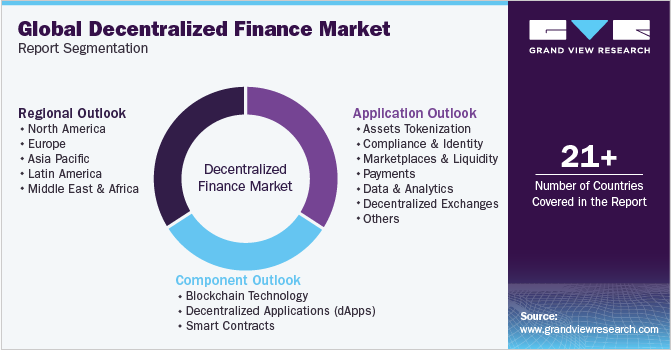
-
Component Outlook (Revenue, USD Million, 2020 - 2030)
-
Blockchain Technology
-
Decentralized Applications (dApps)
-
Smart Contracts
-
-
Application Outlook (Revenue, USD Million, 2020 - 2030)
-
Assets Tokenization
-
Compliance & Identity
-
Marketplaces & Liquidity
-
Payments
-
Data & Analytics
-
Decentralized Exchanges
-
Prediction Industry
-
Stablecoins
-
Others
-
-
Regional Outlook (Revenue, USD Million, 2020 - 2030)
-
North America
-
U.S.
-
Canada
-
-
Europe
-
U.K.
-
Germany
-
France
-
-
Asia Pacific
-
China
-
India
-
Japan
-
South Korea
-
Australia
-
-
Latin America
-
Brazil
-
Mexico
-
-
Middle East & Africa
-
Kingdom of Saudi Arabia (KSA)
-
UAE
-
South Africa
-
-
Frequently Asked Questions About This Report
b. The global decentralized finance market size was estimated at USD 13.61 billion in 2022 and is expected to reach USD 16.33 billion in 2023.
b. The global decentralized finance market is expected to grow at a compound annual growth rate of 46.0% from 2023 to 2030 to reach USD 231.19 billion by 2030.
b. North America dominated the decentralized finance market with a share of 35.02% in 2022. The dominance can be ascribed to the presence of prominent players such as Compound and Uniswap. Additionally, North America is one of the world’s largest crypto markets, which bodes well for adopting the DeFi market.
b. Some key players operating in the decentralized finance market include Compound Labs, Inc.; MakerDAO; Aave; Uniswap; SushiSwap; Curve Finance; Synthetix; Balancer, Bancor Network; and Badger DAO.
b. Key factors that are driving the decentralized finance market growth include the Increasing adoption of blockchain technology and the Increasing adoption of digitized financial services.
Share this report with your colleague or friend.
![gvr icn]()
NEED A CUSTOM REPORT?
We can customize every report - free of charge - including purchasing stand-alone sections or country-level reports, as well as offer affordable discounts for start-ups & universities. Contact us now
![Certified Icon]()
We are GDPR and CCPA compliant! Your transaction & personal information is safe and secure. For more details, please read our privacy policy.
We are committed towards customer satisfaction, and quality service.
"The quality of research they have done for us has been excellent."





